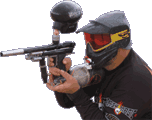  |
|
|
|
|
|
|
  |
|
|
|
|
|
|

What
do you think?
|

Crossfire Hydrotesting and Resurfacing By Bill Mills - Photos by Dawn Mills - Jul 2006 For several years now Crossfire, has been producing fixed output screw-in compressed air systems for paintball. With screw-in air systems there is always a concern that the regulator has to stay secured to the tank when the whole system is unscrewed from the paintgun. For this reason Crossfire has always recommended that their air systems be sent to them when the time comes for hydrotesting. Previously they would remove and inspect regulators before having a tank tested by a subcontractor, but now they have gone a step further, to offer in house hydrotesting and tank refinishing. Federal regulations give the Department Of Transportation (DOT) authority when it comes to the transport of hazardous materials, including compressed gasses. Through inspection at the manufacturing plant and overpressurizing samples to find their point of failure, the DOT hazmat exemption program provides oversight to make sure that the tanks we use for CO2 and compressed air are tough enough to hold the pressures they face during normal use.
Some of the more conscientious manufacturers of fiber wrapped compressed air tanks will include re-test information in their label, with a statement like “retest every 5 years.” That is the length of time for which the exemption is valid. After that time period, the tank may not be filled (there are legal penalties for filling and transporting a tank that is no longer under an exemption) until it has been re-certified. For tanks which don’t state how often they must be tested, this information can be found by looking up their exemption number at hazmat.dot.gov. In general, many of the smaller aluminum CO2 tanks do not require retesting, while larger CO2 tanks like 20 ounce sizes must be retested every five years – though many players opt to simply replace them, since that is often less expensive than retesting. For fiberglass or carbon fiber wrapped HPA cylinders on the other hand, with their higher price tag, retesting is much more affordable and must be performed every 3 or 5 years, depending on the particular tank model’s exemption. Determining when a cylinder needs retesting requires finding both how often retesting is required, and knowing when the tank was made. The tank’s month and year of manufacture will always be on the tank, with the manufacturer’s initials or symbol between them. Living in an area full of SCUBA divers, finding a hydrotester locally, is not all that difficult. Surprisingly when Crossfire announced their hydrotesting service, their price was almost 50 percent less than having it done locally – a little lower than or break even when considering the cost of shipping. A few older tanks made the trip up to Kalamazoo to be re-certified, along with a newer tank to try out their new “spa service.”
Fiber wrapped tanks consist of an internal aluminum cylinder that is reinforced with a wrapping of either glass or carbon fiber which is sealed in resin. While scratches in the outer layer of resin are unsightly, it is physical damage such as fraying, burning or breakage of the fibers that can disqualify a tank from re-certification.
Tanks that pass certification are marked with a label bearing the name of the hydrotester, and the re-certification date. Standard practice is to place this label above and to the right of the cylinder’s existing label, and to cover it in an epoxy resin to prevent peeling, and to make certain it can’t be moved in a later attempt to cover tank damage.
All of the tanks sent in to Crossfire passed re-certification, and were given the company’s new “spa treatment.” This brand new service provides a new coating to the full tank, not just a band aligned with the retest sticker. Like the label sealing it too is performed prior to hydro.
All of the tanks had been well cared for – with tank covers used to protect them from abuse on the field. Even so, one had a chip in its finish from a fall in the workshop, and another had some very gloppy epoxy over the sticker from an earlier recertification.
The spa treatment coated these tanks with a fresh outer coat which filled in the minor scratches and smoothed over the lumpy epoxy. The used tanks literally came back looking brand new. Crossfire is hoping this service will appeal especially to store owners and players who deal in used gear, by increasing the value of a used tank.
Hydrostatic testing and re-certification
is a required part of both legal and safe use of compressed air systems
in paintball. Crossfire’s DOT certified testing service provided
the benefits of being performed by a tester already familiar with paintball
regulators, with the option of resurfacing the cylinders to replace the
marks of normal wear and minor damage with a factory new exterior.
|
| Copyright © 1992-2019
Corinthian Media Services. WARPIG's webmasters can be reached through our feedback form. All articles and images are copyrighted and may not be redistributed without the written permission of their original creators and Corinthian Media Services. The WARPIG paintball page is a collection of information and pointers to sources from around the internet and other locations. As such, Corinthian Media Services makes no claims to the trustworthiness or reliability of said information. The information contained in, and referenced by WARPIG, should not be used as a substitute for safety information from trained professionals in the paintball industry. |